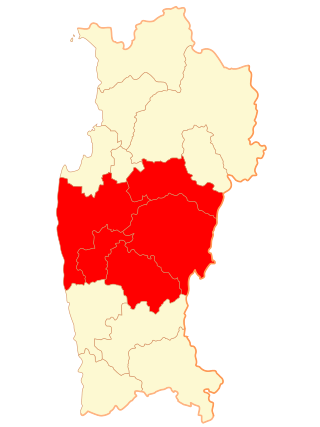This article needs additional citations for verification .(February 2024) |
| |||||
| Decades: | |||||
|---|---|---|---|---|---|
| See also: | |||||
The following lists events that happened during 1920 in Chile.
This article needs additional citations for verification .(February 2024) |
| |||||
| Decades: | |||||
|---|---|---|---|---|---|
| See also: | |||||
The following lists events that happened during 1920 in Chile.

Vicuña is a Chilean commune and city in Elqui Province, Coquimbo Region, founded during the government of Bernardo O'Higgins to secure sovereignty over the Elqui Valley. Poet Gabriela Mistral was born there in 1889. It shares borders to the west with the communes of La Higuera, La Serena and Andacollo, to the east with Argentina and to the south with Paihuano and Rio Hurtado. The commune is administered by the municipality of Vicuña, which is the principal city of the Valle de Elqui.

MercadoLibre, Inc. is an Argentine company headquartered in Montevideo, Uruguay and incorporated in Delaware in the United States that operates online marketplaces dedicated to e-commerce and online auctions. As of 2016, Mercado Libre had 174.2 million users in Latin America, making it the region's most popular e-commerce site by number of visitors. The company has operations in Argentina, Bolivia, Brazil, Chile, Colombia, Costa Rica, Dominican Republic, Ecuador, El Salvador, Guatemala, Honduras, Mexico, Nicaragua, Panama, Paraguay, Peru, Uruguay and Venezuela. In 2023 Time included Mercado Libre in the list of the 100 most influential companies in the world.

Coquimbo is a port city, commune and capital of the Elqui Province, located on the Pan-American Highway, in the Coquimbo Region of Chile. Coquimbo is situated in a valley 10 km (6 mi) south of La Serena, with which it forms Greater La Serena with more than 400,000 inhabitants. The commune spans an area around the harbor of 1,429.3 km2 (552 sq mi). The average temperature in the city lies around 14 °C (57 °F), and precipitation is low.

The Elqui River starts in the west Andes and flows into the Pacific Ocean near the Chilean city of La Serena. It is a wine and pisco producing area. Vicuña, the main town of the middle valley, was the home of Nobel Laureate poet Gabriela Mistral.

Club Deportivo Jorge Wilstermann, known simply as Wilstermann, is a Bolivian football club from the city of Cochabamba, founded on 24 November 1949 by a group of workers of Lloyd Aereo Boliviano. It is named after Bolivian aviator Jorge Wilstermann. Wilstermann is one of the three most frequent winners of the Primera Division de Bolivia and the first Bolivian team to qualify to the Copa Libertadores semi-finals.

The Radical Democracy, was a Chilean centre-right political party. The party, created in 1969, was dissolved in 1973, and reappeared in 1983 before disbanding permanently in 1990.

Limarí Province is one of three provinces of the Chilean region of Coquimbo Region (IV). Its capital is the city of Ovalle

Alberto Jorge Fouillioux Ahumada was a Chilean football midfielder and striker who earned 70 caps and scored 12 goals for the Chile national team during his career.
El Señor de la Querencia is a nighttime soap opera broadcast by Televisión Nacional de Chile. El Señor de la Querencia is set in a rural estate in Colina, Chile in 1920. It differs from former Chilean series by the large amounts of domestic violence, sexual abuses, extortions, threats, torture and violence shown as part of the plot. Chilean minister Laura Albornoz expressed her concern about the impact of the repeatedly shown domestic violence and sexual abuses shown in the soap opera.
Julio Alberto Crisosto Zárate is a Chilean former footballer who played in 5 clubs in Chile and the Chile national football team in the 1975 Copa América.

Julio Alberto Mercado Illanes (1920–1994) was a Chilean accountant, businessman and politician. He was born in Vicuña, in the Elqui Valley area on January 14, 1920, and died in Santiago on April 23, 1994. His remains are interred in Vicuña. He was the son of Juvenal Mercado and Zunilda Illanes Olivares.

The Foreign Minister of Bolivia is the head of the Ministry of Foreign Affairs. The current minister is Celinda Sosa Lunda, who was appointed by president Luis Arce in November 2023.
Illanes is a Spanish-origin surname, appearing in the names of:
The following lists events that happened during 1994 in Chile.

Julio Alberto González Bascuñán is a Chilean football referee. He has refereed matches in the 2015 and 2016 Copa América, and served as an arbitrator for the final stages of the 2018 FIFA World Cup.

Federación Obrera de Magallanes was a trade union movement based in Punta Arenas, Chile, active between 1911 and the mid-1920s. FOM was targeted in a deadly arson attack in 1920.

The National Directorate of Intelligence (Spanish: Dirección Nacional de Inteligencia), or (DINI), is the premier intelligence agency in Peru. The agency is responsible for national, military and police intelligence, as well as counterintelligence.

Jaime Patricio Vadell Amión is a Chilean film, theatre and television actor. He is one of the most recognisable faces in Chilean telenovelas and cinema, having played key roles in films directed by Raúl Ruiz, Silvio Caiozzi and Pablo Larraín.

Alberto Illanes Puente is a Bolivian football manager and former player who played as a defender. He is the current manager of Nacional Potosí.